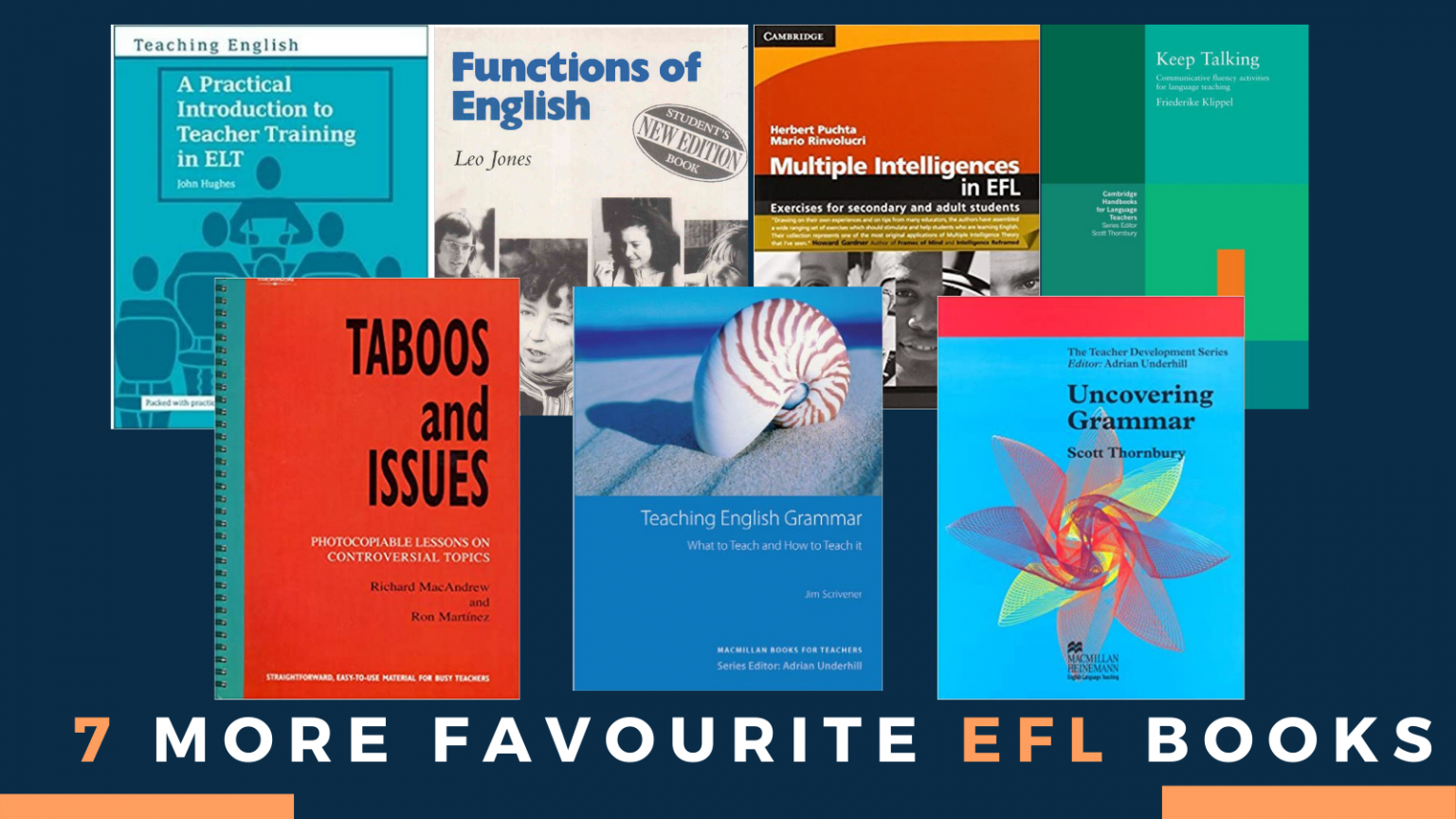Best EFL Books – 7 More to Consider
EFL Magazine is delighted to highlight 7 EFL Books suggestions which we hope may be useful to you all. A big EFL Magazine Thank You! to our 7 book reviewers for taking the time out of their busy schedules to provide their helpful insights which are of benefit to all of us bibliophiles both here at the Magazine and in our wider circle of friends. As always, we here at EFL Magazine strive to be impartial, as such, the book reviews, are arranged in alphabetical order. Enjoy!
1. A Practical Introduction to Teacher Training by John Hughes
Reviewed by Dimitra Gkotosopoulou
This is the ideal book for teachers who are slowly moving their careers towards teacher training in more informal contexts. It perfectly combines practical tips and photocopiable training materials with a solid bite-sized theoretical background. In the book you can find twenty-seven user-friendly training tasks and observation form templates, along with models and examples, which can transform a stressful training session into an enjoyable and rewarding activity for both the trainee and the trainer.
A few years ago, I found myself in this same position of being an upcoming teacher trainer and I was inspired by this books philosophy. More than anything, makes it very clear that teacher training should not be confused with teacher evaluation and performance reviews, which seems to be the unfortunate reality. The three key words that I have personally taken from this book and which have become part of my professional identity as a teacher trainer are: “Empathy”, “Support”, and “Rapport”.
2 . Functions of English by Leo Jones
Reviewed by Charlie Ellis
A turning point in my teaching career arrived via a battered, yellowing copy of a book published in 1979… so out-dated that it contained references to telegrams, powerful trade unions and vinyl records. But in the same way that vinyl records have continued appeal, the teaching approach that inspired this book contains some key insights. The book was Notions in English by Leo Jones. Its sister volume, Functions of English has since become a great inspiration and resource for my teaching. The engaging, witty and demanding character of Jones’ work has kept me returning to it time and again.
I came across Jones’s work whilst teaching at a school which had a broadly Task-Based Learning approach (TBL). I, along with many of the other teachers, struggled not so much in the creation of engaging materials and tasks, but in the language extension/input phase of the lesson. Jones’ work helped me with that phase of TBL lessons by providing me with a clear target language.
Functions of English is fairly traditional in its structure. Most sections follow a PPP model, albeit, one which focuses on language functions rather than grammar points. Jones’s work is very much part of the Communicative Language Teaching strand in ELT, so the speaking activities are particularly engaging. What sets this work apart are the rich chunks of language which permeate every section, not just a few useful phrases but a substantial set of functional phrases. Functions of English is something of a forgotten classic though ELT figures such as Hugh Dellar have praised it. It is a pity that there are no contemporary course books with a similar character.
3 . Keep Talking: Communicative Fluency Activities for Language Teaching By Friederike Klippel
Reviewed by Eduardo Gonzalez
Keep Talking is the title of a collection of communicative activities for language teachers. These activities are aimed at maximising students’ language production and interaction.
Klippel, collected these activities throughout her teaching career. She emphasises that they are not a final product so the teacher needs to adjust accordingly. In order to select an activity, the teacher should have a particular group of learners in mind.
The book offers a comprehensive alphabetical table of activities. Activities are also grouped according to type, for example, warming-up exercises, interviews, discussion games, etc. In addition, there is a list of speech acts that could help teachers with their selection.
The introduction explores the book content and the writer gives teachers basic tips on how to use the materials. A section on ways to arrange different discussion groups is also included.
This book was first published in 1984 and it is now on its 20th reprint. Keep Talking is part of the Cambridge Handbooks for Language Teachers series by Penny Ur.
Keep Talking accomplishes what it is sets out to do, which is to become an unlimited source of communicative activities that requires a low amount of preparation time.
4. Multiple Intelligences in EFL –Exercises for Secondary and adult students By Herbert Puchta, Mario Rinvolucri
Reviewed by Theodora Papapanagiotou
This week my very favourite subject: Multiple intelligences (hereinafter, MI). I came across this wonderful series of books and I could not put this book down! It contains activities for all levels and all levels of intelligence. There is even a section with proposed activities using your course book as well, whichever course book that may be!
In the first section, the book contains general MI activities with lots and lots of ideas. The second section proposes activities you can do with your students with the course book, such as: interviews, poem creations, cinquains and metaphors.
The third section is called ‘looking in’ and has to do with the intra-personal intelligence. A bit of soul searching? An activity that impressed me the most in this part of the book, was ‘listen with your mind’s eye’, how to read between the lines, how to understand the meaning of poems.
Finally, the last section is concerned with self-management, brainstorming and my favourite – ‘the story of your hopes and dreams’.
I am really enthusiastic about the final one mainly because it gives you the chance to be creative and to adjust the activities to your students’ needs, strengths, and weaknesses.
It presents a variety of things you can do in the classroom, in pairs, and with a little adjustment, even in one to one lessons.
5. Taboos and Issues
Reviewed by Chris Rush
My favorite EFL book is called Taboos and Issues. It is a book full of speaking lesson plans that are considered unsuitable for general course books, and it gives adults the opportunity to discuss controversial issues. It includes politics and religion certainly, but also ethical issues like swearing, euthanasia, lying, and more.
Whilst certainly not for every classroom, with occasional use with mature students it provides for an excellent change-of-pace type of lesson. It generates lots of those “I can explain this in my own language but not in English” moments that are helpful for building fluency. The lesson plans in the book are structured, with a warm-up activity, some grammar and vocabulary, and some gap-fill or multiple choice questions to work on a specific language point.
The final activity of each lesson is the most interesting, where the students share what they think; for example, whether or not something like bullfighting should be banned, or whether jokes that make fun of people are acceptable in certain circumstances, or if it is ok to lie to protect someone’s feelings. I believe this book is out of print so keep in mind that some of the lessons may contain out-of-date attitudes about certain subjects.
6. Teaching English Grammar: What to teach and how to teach it by Jim Scrivener
Reviewed by Margie Beck
I love using this book because it is designed for teachers and their everyday work. It is both practical as well as theoretical. The author has tried to give examples that will appeal to students, it adds plenty of suggestions for further activities and leaves room for teachers to add their own examples that meet their particular needs and contexts.
The addition of teaching tips in each chapter helps beginner teachers to make their teaching relevant!
I support local staff in East Timor to teach English, so this book, with its 70 chapters, each of which deals with one English grammar concept, helps me to help my staff. I use it every week!
7. Uncovering Grammar by Scott Thornbury
Reviewed by Justin Wyllie
In essence, this is a short book which is based around one idea. Grammar emerges through an intrinsic self-organising process in the student and as such, it cannot be ‘taught’ in a conventional sense. Exposure is more important than explanations. The author relies upon ideas from artificial intelligence and machine learning. When there is sufficient input, the system (in the brain) will make the necessary connections. This is an extremely interesting thesis. The author supports the idea through, for example, snippets of children’s speech.
Another useful concept is the idea that the more distant, in time and space, a subject is from the speaker, the more grammar is required to discuss it. The implications for teaching are that the focus shifts from the curriculum and the textbook to supporting the processes within the student’s mind. The teacher assumes a new role as facilitator. My only caveat with the thesis is that it seems to rely heavily on ideas about how children learn a first language.
I am not 100% sure that these ideas transfer completely to the experience of older teenagers or adults learning a second language. Perhaps adults can also learn by, for example, mapping first-language structures onto second-language structures. But, all in all, a very useful and positive book about language teaching. The author includes some useful photocopiable ‘grammaring up’ exercises.
Our book reviewers (in alphabetical order) are:
- Charlie Ellis
Charlie Ellis is a researcher and EFL teacher, based in Edinburgh. He contributes to the What They don’t Teach on the CELTA blog at
- Chris Rush
Website www.off2class.com
- Dimitra Gkotosopoulou
- Eduardo Gonzalez
- Justin Wyllie
Email: [email protected]
- Margie Beck
- Theodora Papapanagiotou







